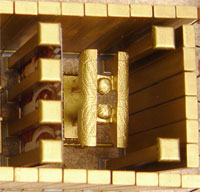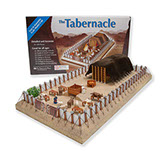<< Previous: Golden Altar of Incense
Next: Ark of the Covenant >>
The Holy of Holies and the Veil
Within the Holy Place of the tabernacle, there was an inner room called the Holy of Holies, or the Most Holy Place. Judging from its name, we can see that it was a most sacred room, a place no ordinary person could enter. It was God’s special dwelling place in the midst of His people. During the Israelites’ wanderings in the wilderness, God appeared as a pillar of cloud or fire in and above the Holy of Holies. The Holy of Holies was a perfect cube — its length, width and height were all equal to 15 feet.
A thick curtain separated the Holy of Holies from the Holy Place. This curtain, known as the “veil,” was made of fine linen and blue, purple and scarlet yarn. There were figures of cherubim (angels) embroidered onto it. Cherubim, spirits who serve God, were in the presence of God to demonstrate His almighty power and majesty. They also guarded the throne of God. These cherubim were also on the innermost layer of covering of the tent. If one looked upward, they would see the cherubim figures.

Purchase a Tabernacle Model Kit
A great visual aid for teaching about the tabernacle with adults and children.

The word “veil” in Hebrew means a screen, divider or separator that hides. What was this curtain hiding? Essentially, it was shielding a holy God from sinful man. Whoever entered into the Holy of Holies was entering the very presence of God. In fact, anyone except the high priest who entered the Holy of Holies would die. Even the high priest, God’s chosen mediator with His people, could only pass through the veil and enter this sacred dwelling once a year, on a prescribed day called the Day of Atonement.
The picture of the veil was that of a barrier between man and God, showing man that the holiness of God could not be trifled with. God’s eyes are too pure to look on evil and He can tolerate no sin (Habakkuk 1:13). The veil was a barrier to make sure that man could not carelessly and irreverently enter into God’s awesome presence. Even as the high priest entered the Holy of Holies on the Day of Atonement, he had to make some meticulous preparations: He had to wash himself, put on special clothing, bring burning incense to let the smoke cover his eyes from a direct view of God, and bring blood with him to make atonement for sins.
“But only the high priest entered the inner room, and that only once a year, and never without blood, which he offered for himself and for the sins the people had committed in ignorance.” (Hebrews 9:7)
So the presence of God remained shielded from man behind a thick curtain during the history of Israel. However, Jesus’ sacrificial death on the cross changed that. When He died, the curtain in the Jerusalem temple was torn in half, from the top to the bottom. Only God could have carried out such an incredible feat because the veil was too high for human hands to have reached it, and too thick to have torn it. (The Jerusalem temple, a replica of the wilderness tabernacle, had a curtain that was about 60 feet in height, 30 feet in width and four inches thick.) Furthermore, it was torn from top down, meaning this act must have come from above.
As the veil was torn, the Holy of Holies was exposed. God’s presence was now accessible to all. Shocking as this may have been to the priests ministering in the temple that day, it is indeed good news to us as believers, because we know that Jesus’ death has atoned for our sins and made us right before God. The torn veil illustrated Jesus’ body broken for us, opening the way for us to come to God. As Jesus cried out “It is finished!” on the cross, He was indeed proclaiming that God’s redemptive plan was now complete. The age of animal offerings was over. The ultimate offering had been sacrificed.
We can now boldly enter into God’s presence, “the inner sanctuary behind the curtain, where Jesus, who went before us, has entered on our behalf.” (Hebrews 6:19-20)
“Therefore, brothers, since we have confidence to enter the Most Holy Place by the blood of Jesus, by a new and living way opened for us through the curtain, that is, his body …let us draw near to God with a sincere heart in full assurance of faith.” (Hebrews 10:19-22)
The Holy of Holies is a representation of heaven itself, God’s dwelling place, which we have access now through Christ. In Revelations, John’s vision of heaven — the New Jerusalem — also was a perfect square, just as the Holy of Holies was (Revelation 21:16).
“For Christ did not enter a man-made sanctuary that was only a copy of the true one; he entered heaven itself, now to appear for us in God’s presence. Nor did he enter heaven to offer himself again and again, the way the high priest enters the Most Holy Place every year with blood that is not his own. …But now he has appeared once for all at the end of the ages to do away with sin by the sacrifice of himself.” (Hebrews 9:24-26)
<< Previous: Golden Altar of Incense
Next: Ark of the Covenant >>
What is the Tabernacle of Moses?
- Diagrams of the Tabernacle and Basic Layout
- The Gate
- The Brazen Altar
- The Laver
- The Menorah
- The Table of Showbread
- The Golden Altar of Incense
- The Ark of the Covenant and Atonement Cover
Why Study the Tabernacle of Moses?
Why the Jewish Old Testament Tabernacle?
Sunday School Lessons on the Tabernacle
I WANT TO LEARN
ABOUT GOODSEED
The Monthly
GoodSeed eNewsletter
Sign up to receive articles, testimonies, sneak peeks of new resources & upcoming seminars. You'll receive a PDF copy of The Tabernacle: Model of Messiah as a thank you for partnering with us.
© 2023 GoodSeed International. All rights reserved.


